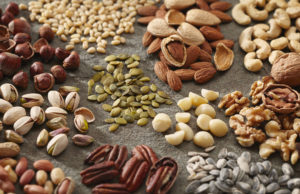During my practice, I often recommend removing dairy from people’s diets, either to address gut dysfunction; alleviate allergies; or heal inflammatory conditions such as eczema, asthma, and myriad mental health issues. Almost every patient will ask me a question, what about calcium if I don’t eat dairy? And a lot patients mentioned that they take calcium supplements on daily basis for long term.
It’s interesting that we’ve become a culture that consumes calcium-leeching foods and the same time take supplementation to build this important mineral in the body.
Sadly, more research is revealing that the body cannot properly absorb calcium from supplements. This form of calcium is showing to lead to more calcification in the bones and arteries.
So where should we get our calcium? From the best place, of course. . . FOOD! Best food sources of Calcium are beans, nuts (almonds and brazil nuts are highest), greens (parsley, collards, dandelion, kale, etc.), sea vegetables (hijiki, kelp, wakame are highest), sesame seeds/tahini, canned salmon and sardines with bones and bone broth.
CALCIUM ABSORPTION:
Below are some suggestions for maximizing your calcium absorption through food intake and food elimination, with brief detailing further below:
- consider eliminating or at least limiting foods that contain caffeine
- eliminate or limit refined carbohydrates and sugars (all of which increase the excretion of calcium from the body)
- balance animal protein with more vegetable proteins from beans, nuts, whole grains and seeds
- increase fruit and vegetable intake (especially the latter)


- eliminate soft drinks completely
- add whole soy foods in moderation and if not contraindicative with your medical regime (tempeh, miso, edamame are best as they are not as processed) for their isoflavones, which have been shown to increase bone density
- add alfalfa (sprouts on salads, etc.)
- add green tea (good vitamin K content which helps with calcium absorption)
- Sugar: Sugar intake alters the calcium-phosphorus ratio in the blood, causing the phosphorous level to drop. When not enough phosphorous is present in the blood, the body cannot properly absorb calcium.
- Protein: A diet high in protein but low in alkalizing fruit and vegetables is known to have an acidic effect in the blood. The focus should not necessarily be on lowering protein intake, but instead on increasing consumption of low-glycemic fruits and vegetables for a more balanced diet.
- Fruits/veggies: These foods provide vitamin K, which activates osteocalcin—a protein that anchors calcium into the collagen matrix—along with magnesium, zinc, potassium, and fibers that aid the body in the absorption and assimilation of minerals. Leafy greens and broccoli are especially great sources of vitamin K and folic acid, which also helps with bone nutrients, not to mention that they are calcium powerhouses!
- Dairy: moderate dairy intake. If using, full fat is preferable and raw is best. Contrary to popular sentiment, the calcium in dairy foods comes in an unbalances relationship with phosphorous. Therefore a lot of the calcium from dairy is incompletely absorbed or incorrectly assimilated. The full-fat and raw dairy sources are better because of they are rich in the fat soluble vitamins that aid in calcium absorption.
SUPPLEMENTATION:
Supplementation for bone support goes beyond calcium. Calcium is only one of at least 12 minerals that build strong bones. Bones are made of: Calcium, Potassium, Magnesium Manganese, Silica, Iron, Selenium, Boron, Phosphorous, Sulfur, Chromium, Zinc. Osteoporosis is not defined by a loss of calcium, but by a loss of minerals.
Although calcium plays an important role in bone health, adequate amounts of magnesium are needed for bones to be able to metabolize calcium normally. The fat soluble vitamins (A, D, E, K) and the essential fats are also key.
Note On Magnesium:
It’s common knowledge that vitamin D is essential for efficient calcium utilization. Magnesium plays a large role in the absorption of calcium by activating enzymes that play a role in healthy bone formation, regulating the transport of calcium, and it plays a role in converting Vitamin D into its useable form, which in turn, enhances calcium absorption.
Calcitonin is a hormone that increases calcium in the bones and keeps it from being absorbed into the soft tissue. Magnesium stimulates calcitonin production and therefore increases calcium in the bones while drawing it out of the soft tissue. Many forms of arthritis are characterized by excess calcium appearing in the soft tissues while skeletal calcium is lacking.
A magnesium-rich diet is generally a great cure for these types of osteoarthritis as well as most forms of calcium deficiency.
The food groups in order of their magnesium content are: dried seaweed (wakame, kombu, kelp), beans (mung, aduki, black, lima), whole seed-grains (buckwheat, millet, quinoa), nuts & seeds (almonds, cashews, filberts, sesame seeds), high chlorophyll foods like wheat or barley grass, spirulina, blue-green algae, chlorella), raw chocolate and bone broths!


During the pandemic, it’s the best timing to learn how to cook the health food as our medicine. Go to youTube, or Pinterest, there are tons of healthy recipes that are waiting for you. Learn to cook your bone broth, kelp soup…eat delicious food and be healthy!